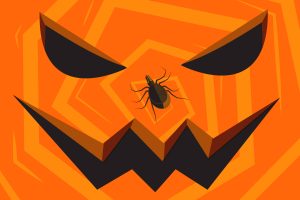
(Updated July 1)
Because of their potential to cause serious illness, a tick bite can be a frightening event.
An understanding of the facts of tick-borne illnesses can put the risk of a tick bite into perspective.
“The dangers of tick bite are very low,” says Dr. Henry Feder, professor of family medicine and pediatrics at UConn Health. “Most tick bites go unnoticed. For every one your find, there probably are 10 you don’t’ find. Clinical disease from a tick bite is still very unusual.”
When it comes to beliefs and popular notions about insect-borne diseases, Feder has just about seen and heard it all. Here he offers 12 things to understand about ticks and the tick-borne illnesses seen in Connecticut.
- The most common ticks in Connecticut are the deer tick (or black-legged tick) and the much larger dog tick.“The deer tick is the one that carries multiple pathogens. These infectious culprits are frequently in the news, the most common infection being Lyme disease,” Feder says.After hatching, the first stage of deer tick is larva, which usually feed on mice, a small percentage of which will become infected with the bacteria that causes Lyme disease. The next stage, which takes a year to develop, is nymphs, which come out in spring and early summer. Nymphs will feed on any mammal, including humans. The third and final stage are adult ticks, which come out at the end of summer and fall. Adult ticks are not vigorous feeders.
- A tick on the skin doesn’t guarantee Lyme disease.“A lot of times when you find a tick and remove it, that’s all you need, because it hasn’t attached or hasn’t been on long enough to pass an infectious agent,” Feder says. “Especially for Lyme, you need at least 24 hours, but more likely 48 hours, for them to engorge, and it’s the engorged tick that can pass Lyme disease. A tick crawling on the skin offers no danger if flicked off.”
- If you are bitten by a deer tick, the odds are good that it is not infected with the bacteria that cause Lyme disease.“The risk of getting Lyme disease from a tick bite is small – 1% to 2% in an endemic area, and in areas that are not as endemic, the risk is a lot smaller. Also, a deer tick has to be attached for at least 36 to 48 hours to cause Lyme disease.”
- The best way to avoid tick bites is to use an insect repellent containing 20% to 30% of the active ingredient DEET. Other effective repellents are available, but DEET is easily recognized on the label in the list of ingredients.“In addition to using DEET, people should do careful tick checks of their whole body after being outdoors and exposed to ticks,” Feder says. “Clothing can also be treated with non-DEET insect repellents, but these lose their efficacy after washings.”
- After a deer tick bite, the rash of Lyme disease occurs in three to 30 days.“Most tick bites go unnoticed. The majority of the Lyme disease rashes are confluent red, with less than half resembling a ‘bull’s-eye.’ The bull’s-eye is very photogenic and is frequently shown in publications.”
- Lyme disease is treatable at all stages with antibiotics.“Borrelia burgdorferi, the bacteria that causes Lyme disease, doesn’t have the capability to become antibiotic-resistant. Effective oral antibiotic therapies include doxycycline, amoxicillin, and cefuroxime, and these antibiotics have remained effective for decades.”
- Later stages of Lyme disease that can follow the rash include a nerve palsy, or a weakness in one side of the face; meningitis, characterized by high fever and a stiff neck; carditis, which usually involves slowing of the heart rate and can lead to fainting; and arthritis of a large joint, especially the knee.“All these stages of Lyme disease can be treated and cured with one course of two-to-four weeks of antibiotics,” Feder says.
- “Chronic Lyme” disease has been defined by some physicians as a Lyme infection that remains active despite weeks, months, or years of antibiotics.“One can’t say chronic Lyme doesn’t exist, because you can’t prove the negative,” Feder says. “But chronic Lyme infection unresponsive to antibiotics has been looked for scientifically and has not been found. After getting treated with two to four weeks of antibiotics, the bacteria that cause Lyme disease are gone. Following Lyme disease, a small number of people may feel unwell for a long time. The cause of these post-Lyme symptoms, which include fatigue, headaches, trouble concentrating, and joint pain, is unknown. Severe fatigue can follow almost any illness, for example mononucleosis. After infection, the blood test for Lyme disease may remain positive indefinitely, irrespective of resolving or persistent symptoms.”
- Other infectious organisms may be carried by the deer tick, including anaplasma and babesia. Anaplasma, which is a lot less common than Lyme disease, causes high fever, a reduction in the white blood cell count, and a reduced platelet count. With Lyme disease, the blood counts are usually normal.“Anaplasma can be treated with doxycycline, which is also an effective treatment for Lyme disease. Babesiosis, which is very rare, is usually only a threat to those who’ve had their spleen removed or are immune suppressed. Most of the time babesiosis is cleared automatically by the spleen, and most people infected with babesia never know it.”
- Rocky Mountain spotted fever is carried by the dog tick, which, unlike the deer tick, is easily seen without magnification.“Rocky Mountain spotted fever is very, very rare in Connecticut, with at most one or two cases reported each year. Patients with Rocky Mountain spotted fever are usually very sick with high fever, severe headache, and a dramatic rash. The rash, which looks nothing like the Lyme eruption, is characterized by tiny dark red spots beginning on the hands, feet, arms and legs. Rocky Mountain spotted fever can be treated with doxycycline.”
- The term “ehrlichiosis” is confusing because the bacteria that used to be called Ehrlichia phagocytophilum is now called Anaplasma phagocytophilum, and the infection that used to be called ehrlichiosis and is now called anaplasma. Reported cases of ehrlichiosis in Connecticut most likely in fact are anaplasma cases.“Microbiologists sometimes change the names of bacteria, which results in confusion both by patients and doctors, and that’s what happened in this case,” Feder says. “Ehrlichia ewingii has kept its name and causes ehrlichiosis. The good news is, ehrlichiosis is not carried by the deer tick but the lone star tick, and the lone star tick is not commonly found in Connecticut.”
- Once a tick is removed, sending it for testing frequently does more harm than good. “Up to 40% of Connecticut deer ticks contain at least one pathogen. But clinical disease from a deer tick bite, even if the tick is carrying a pathogen, is unusual. Finding a pathogen in a culprit deer tick is usually not clinically relevant. The result is unnecessary worry.”
If you’re concerned, Feder recommends seeing your primary care/family medicine physician, pediatrician, or geriatrician. He also cautions that the internet is full of misinformation, and recommends www.cdc.gov as an authoritative online source.
See Also:
 Tick-or-Treat!
Tick-or-Treat!
UConn Today, Oct. 31, 2018
 Tick-hiker’s Guide to the Galaxy
Tick-hiker’s Guide to the Galaxy
UConn Today, June 23, 2017



